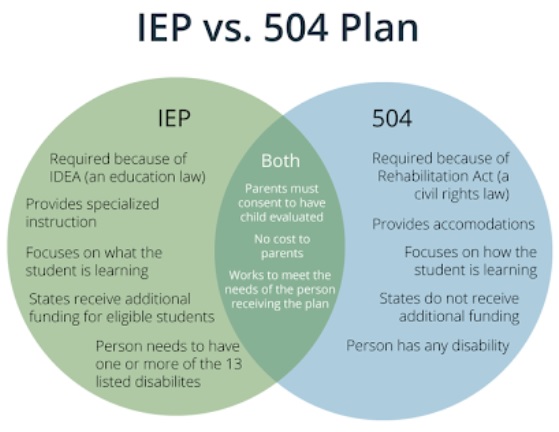Differences Between An IEP And 504 Plan Every Special Educator Must Know
18th March 2024

Even seasoned special educators with SEN CACHE-endorsed courses credentials have occasions when they cannot understand the distinctions between a 504 plan and an IEP. They fail to figure out where to start since they lack guidance and support on the whole matter. The plans, however, are multifaceted and have several functions. So, which is preferable, a 504 plan or an IEP? Read on to find out.
What Is An IEP?
The Individuals with Disabilities Education Act (IDEA) governs an IEP. For qualifying children with impairments, access to special education and related services is guaranteed by this federal statute. With an IEP, a student can get specially planned teaching that is specifically suited to their needs based on their goals, objectives, and disabilities. An IEP is a functioning document that permits the appropriate modifications. To assist the student in making progress in areas impacted by their impairment, a special education teacher in the student's least restrictive environment (LRE) focuses on these objectives.
The plan outlines what services a student requires in school along with the following:
- The classroom supports an instructional placement offered for a student
- Modifications and accommodations
- Additional services such as speech, counseling, occupational therapy, extended school year, transportation, and assistive technology
Hey, do you follow us on Social Media? We regularly share upgraded educational content, tips, feedback and more. Check us out by clicking the profiles here - Facebook / Twitter / LinkedIn / Pinterest / Instagram / YouTube
What Is In An IEP?
Information about the kid and the particular educational plan created to suit their requirements must be included in an IEP. The child's current academic achievement levels and functional performance (PLAAFP), which explains how the child's handicap affects their participation in the general education curriculum, are included in the paper.
The following IEP components are also necessary for IDEA, according to the PLAAFP:
- Measurable yearly goals
- Progress reporting
- Supplemental aids, special education, and related services
- Less restrictive environment
- Participation in district-wide and state-wide tests
- Service delivery description
- Post-secondary transition components
- Transition activities and services
What Is A Section 504 Plan?
A 504 plan covers Section 504 of the Rehabilitation Act, a federal civil rights provision that guarantees that no one is discriminated against because of their disability. These plans don't have goals or objectives, but they do offer assistance and adjustments. Periodically, 504 plans are evaluated according to necessity. Parents have the right to seek a meeting to discuss the plan more frequently if they believe it is necessary.
What Is In A 504 Plan?
A 504 plan's contents are not required, but schools design customized modifications to meet each student's requirements according to their condition. Among many other things, accommodations may be provided by bigger print, accessible technology, preferred seating, written instructions, pre-lesson notes, and more.
Who Qualifies For An IEP?
Students may be eligible to receive free and adequate education (FAPE) in special education under 13 different categories, as per IDEA:
- Autism
- Deafness
- Deaf-blindness
- Emotional disturbance
- Intellectual disability
- Hearing impairment
- Multiple disabilities
- Other health impairment
- Orthopedic impairment
- Speech or language impairment
- Specific learning disability
- Visual impairment
- Traumatic brain injury
IEPs are only valid for kids in grades K–12; when a student receives their high school graduation, they are no longer valid. Each IEP, which is a legally enforceable document, offers a detailed plan for customized teaching and intervention in the areas where a student's disability has an impact.
Who Qualifies For A 504 Plan?
They are frequently awarded to kids who might need support rather than specialized education due to a handicap or medical issues. To decide if a 504 plan is required, the school team should consider information from the child's physicians, family, teachers, and other pertinent service providers. Certain kids may be eligible for assistance under a 504 plan even if they are not eligible for special education services under an IEP.
Major Differences Between IEP And 504 Plan

Source: weilcollegeadvising.com
Some of the biggest differences in these two plans are as follows:
- While a 504 Plan frequently focuses on reasonable accommodations, an IEP provides a more detailed description of services and supports that are in line with yearly objectives.
- A 504 Plan is normally developed by local regulations, but an IEP involves a formal review procedure and IEP team meeting. The processes for getting papers are different.
- Both mandate that educational institutions offer students with disabilities a free and suitable public education; all students, regardless of disability, are entitled to educational benefits.
Choose The Appropriate Plan
Both approaches can offer help through modifications and are appropriate for students in grades K–12, but they differ in a few significant ways. There are advantages to both systems for helping children move toward independence. Teachers equipped with SEN-CACHE-Endorsed-Courses will find it easier to comprehend with the two plans and make their pick according to the needs of their students.
We believe education should be accessible for everyone. That’s why we don’t charge for our blogs. Find the right course that will help you in your career with us, contact us at - 1800–212–6400. You can mail us at act@asiancollegeofteachers.com.








